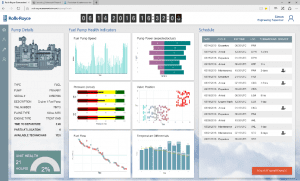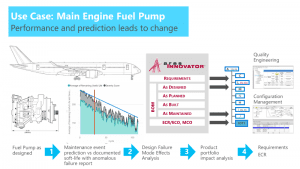Best practices for using the cloud in PLM? It’s all about the data.
 Last week, I was pleased to be joined by Jeffrey Hojlo, program director of product innovation at IDC, on a webcast to explore trends around how global enterprises can maximize their use of the cloud in PLM.
Last week, I was pleased to be joined by Jeffrey Hojlo, program director of product innovation at IDC, on a webcast to explore trends around how global enterprises can maximize their use of the cloud in PLM.
We dove into the digital transformation that is happening today and how this is impacting manufacturers, specifically around their ability to connect their PLM platform capabilities and extract meaningful information to drive product improvements and new services.
First, Jeff shared some fascinating data from IDC around trends driving PLM and product innovation to the cloud, cloud PLM scenarios, and where this market is heading.
IDC says manufacturers are dealing with more complexity than ever around the value chain due to things like connected product capabilities and customer demand. With connectivity being so ubiquitous and speed to market expectations higher than ever, manufacturers need a way to collaborate easily and make sound decisions quickly with data. Product quality is top of mind and manufacturers need to leverage digital technologies to change their ecosystem in order to create digitally enhanced customer-centric business models, get products to market faster, and penetrate new markets.
It was interesting to hear Jeff reiterate what we’ve been telling our customers: the new reality for manufacturers—and most companies in today’s digital age—is that it’s not enough anymore to just manufacture products, makers need to transform into a software companies that use the power of data and intelligence to stay competitive and enable the ultimate customer experience. It’s all about the speed of information flow and decision-making in a complex value chain. This opens up the opportunity for the cloud and other emerging technologies.
And IDC says manufacturers are realizing that value in the cloud and are increasing their investment in PLM cloud strategies. They are specifically looking at a hybrid approach to complement specific scenarios, most importantly to improve product quality management as well as advance their design and engineering capabilities.
Innovation is the number one reason people will move to the cloud
It is clear that as we move to more and more connected products, the focus shifts from operational efficiency and quality to innovation. This is the number one reason people move to the cloud. When you have the ability to use the cloud to access mass storage, mass compute, and advanced technologies like machine learning to help you extract intelligence from big data, it really does make it a great enabler for innovation.
When we talk about transforming products and services, we need to focus in on what it means to have information from connected products. As operational efficiency is paramount for the aerospace industry, for example, when you look at the product lifecycle, what we are talking about is having performance information driving the type of decision-making you need for things like engineering. This is the way we can get improved product quality because we can see so much more in the data; objective data about how the product has performed.
Rolls-Royce: converging physical and digital to deliver a highly valued intelligent product
 As an example, we have built an interesting solution with Rolls-Royce that not only shows the power of connected products, but shows the type of information that can be gathered and its value downstream. By connecting its jet engine monitoring units and other aircraft data acquisition systems to Microsoft Azure, Rolls-Royce is using predictive analytics to provide insights into maintenance planning, fuel management, and overall fleet health in order to help airlines potentially save millions of dollars per year. However, it’s important to point out that this can be used for more than just operational needs such as maintenance. It’s about sharing insights with design engineering and planning teams so they learn how their products perform in real-world situations and then make informed decisions about future enhancements, new solutions and ultimately drive innovation.
As an example, we have built an interesting solution with Rolls-Royce that not only shows the power of connected products, but shows the type of information that can be gathered and its value downstream. By connecting its jet engine monitoring units and other aircraft data acquisition systems to Microsoft Azure, Rolls-Royce is using predictive analytics to provide insights into maintenance planning, fuel management, and overall fleet health in order to help airlines potentially save millions of dollars per year. However, it’s important to point out that this can be used for more than just operational needs such as maintenance. It’s about sharing insights with design engineering and planning teams so they learn how their products perform in real-world situations and then make informed decisions about future enhancements, new solutions and ultimately drive innovation.
The future of PLM in the cloud
Tomorrow, data will facilitate innovation because we can see performance characteristics of the product, and within different circumstances. The work we are doing with Aras with the Aras Innovator PLM System and Microsoft Azure helps to further that innovation by turning raw data into very detailed insights and actions. This can be incredibly powerful as you think about all of the different sorts of information that can really influence the way you go about design.
 In a solution-centric world, the cloud is the enabler for speed, agility, and to enrich the design and engineering process with data. So what’s in store for future cloud PLM scenarios? Jeff says it could be things like a rich, virtual product representation environment—a “digital twin” —that offers a high level of content and context to model performance and quality issues.
In a solution-centric world, the cloud is the enabler for speed, agility, and to enrich the design and engineering process with data. So what’s in store for future cloud PLM scenarios? Jeff says it could be things like a rich, virtual product representation environment—a “digital twin” —that offers a high level of content and context to model performance and quality issues.
I see that the ability to access rich kinds of data sets never before possible until advanced technologies like the cloud and machine learning came into play is truly the future of PLM.
I received a lot of feedback and questions during and after our discussion, so I know that this is a topic that is top of mind for most of you. If you missed it, you can watch the on-demand webcast replay here. There are some resources below that I encourage you to check out to help you get started. In addition, I recommend this excellent IDC white paper written by Jeff on PLM Cloud Scenarios. I’d like to thank Aras Corporation and Engineering.com for hosting this exciting discussion.
LinkedIn: Simon Floyd
Twitter: @FloydInnovation
_____________________________________________________________
Resources
Rolls-Royce Solution Demonstration
- Cloud-based business analytics service
- Industry example templates
- Preconfigured solutions for quick start
- Partners to help accelerate your programs
- Demos: remote monitoring & predictive maintenance
- Business Intelligence with Cortana digital assistant
- Get started and quick start
- Customer examples
Aras Innovator PLM Suite template




